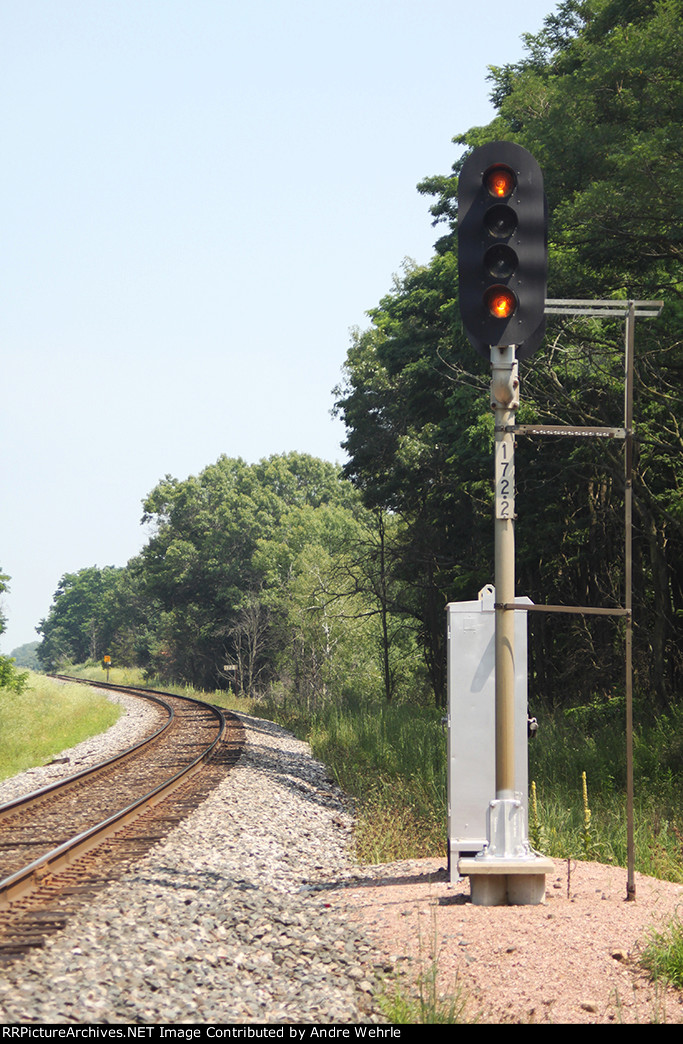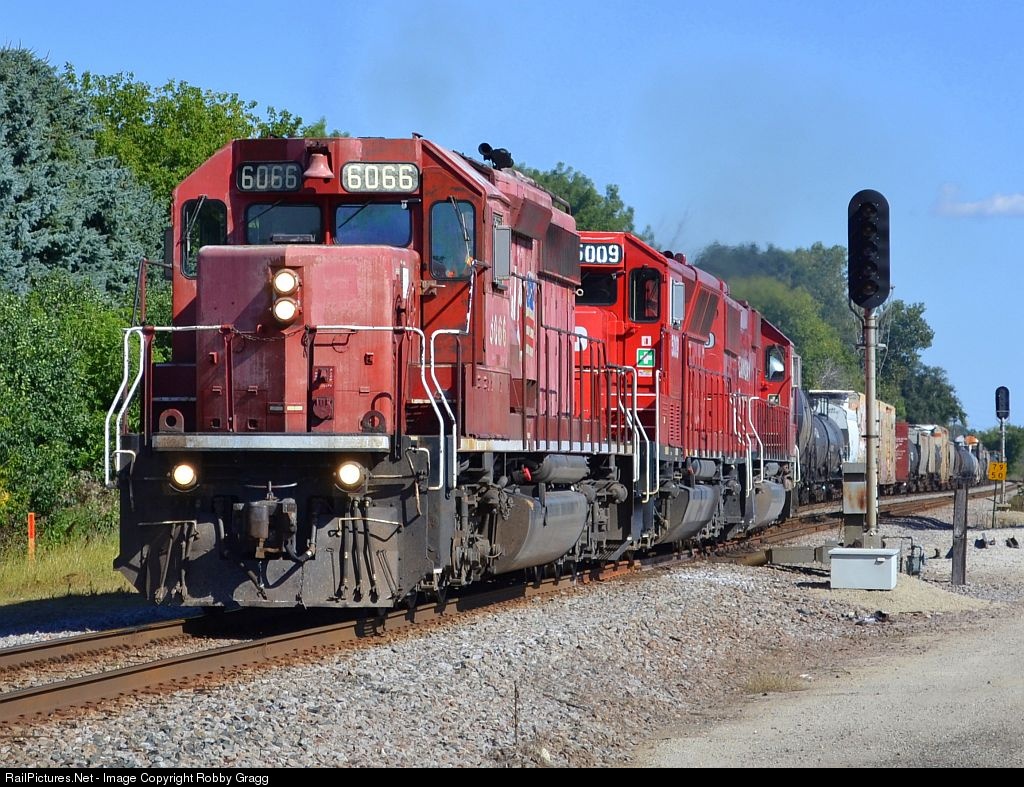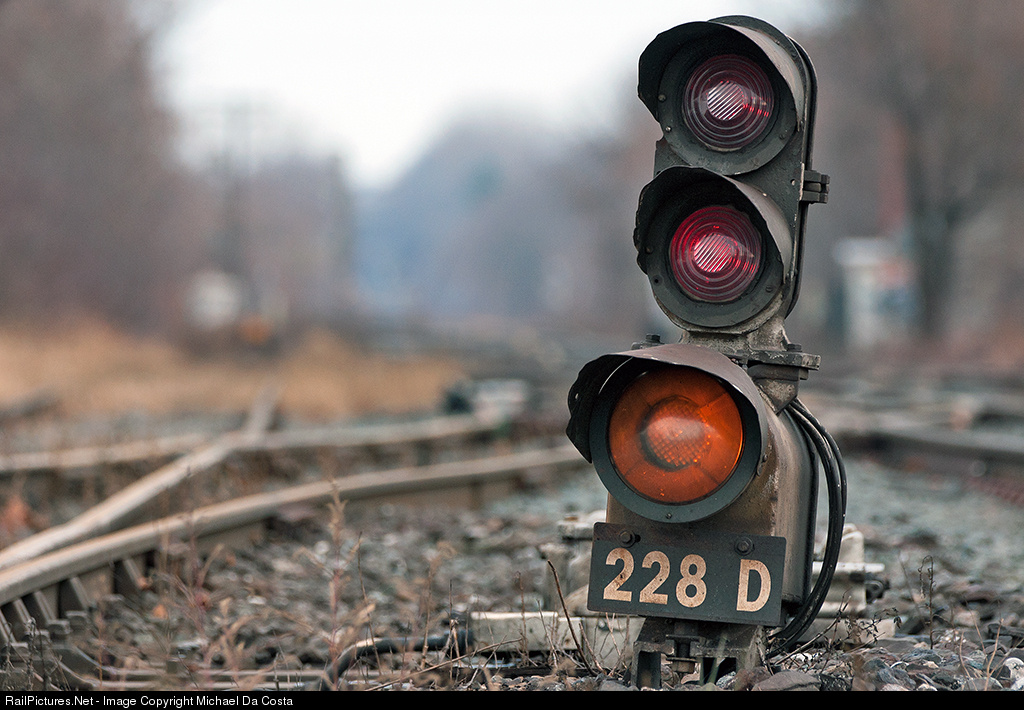The concept of a signal "head" is pretty basic to the understanding of signal aspects. Each head is capable of displaying some chunk of information and in conjunction with other heads on the same signal the entire story is told. In the vast majority of signaling instances the signal heads are easy to identify and are distinct from one another. From the round searchlight targets to the hooded Darth Vaders to the massive position light assemblies, the signal head makes the "X over Y over Z" type North American signal unambiguous in its display. The signal head concept also applies to dwarf signals and "dwarf stacks" are a well known signaling type allowing each dwarf head its own compliment of colors to display.
Even where unit lamps are employed stacks of up to 6 units are not uncommon to create two 3 lamp heads such as those seen here at Amtrak's COVE interlocking.
The thing is...what if you didn't feel like spending that much money on all those pesky signal heads? A virtual signal head is where what would normally act as a single signal head instead serves as 2 or more using the relative placement of lights without the associated spacial placement. This is generally seen as being a rather severe form of cost cutting and is rare even in North America where signaling hardware is already fairly austere. One of the more prominent main line examples is on the former Milwaukee Road main line between Milwaukee and St. Paul, now operated by CP and uses
4-lamp masts to display the full range of weak route signal indications like Y/Y, R/G and R/Y.
Or a 5-lamp mast at interlockings where both Y/Y and L aspects are required.
However the cost effective signaling award might just belong to Conrail for its use of virtual headed 2, 3 and 4 lamp dwarf signals. Now this might be more widespread and I'm probably being a bit unfair picking on Conrail, but on the other hand the NORAC signal aspect system was tweaked specifically for just this sort of low cost signaling so I suspect that Conrail was one of the more aggressive users of the practice. How does NORAC cater to the use of Virtual Heads in dwarf signals you ask? G/*R* for Medium Clear and Y/*R* for Medium Approach avoids having aspects like R/G or R/*Y* create conflicts with a virtual head system. All NORAC dwarf indications can be displayed on a signal with Red on the bottom.
Why would Conrail care so much when it didn't seem to bother other railroads? First of all there was a lot of Rule 251 double track in the Conrail territory and chronically short on cash the road had to cut itself into profitability. This meant that when making new interlockings for single track or even double track CTC a dwarf was a better deal than a mast. While route signaled roads out west could get by with having a single lamp dwarf display full blown Clear off a signingor reverse signaled route, Conrail's speed signaling system really couldn't. Single searchlight or position light dwarfs limited turnouts to slow speeds so virtual head dwarfs could eliminate the problem for the same price.
Conrail went crazy with the concept. A 2-lamp dwarf displaying only Stop, Restricting or Slow Approach could now display Medium Approach. Adding a green lamp gave them Medium Clear, Approach Medium and Approach Limited. Limited Clear was given the coveted *G* dwarf slot so that doesn't really count as a gain, but the
C&O was forced to use *G* for Medium Clear on their non-virtual US&S N-3 signals so the extra flexibility is still there. The only two dwarf indications not covered were Y/Y Approach Slow and G/G Clear, with both requiring a 4th lamp (Clear AND Approach Slow would require 5 lamps). Again, while one might assume the signal engineers would want to put a gap between the greens such as G-Y-G-R that would be an incorrect assumption, especially where a 3-lamp is getting an upgrade to 4-lamp, such as a Rule 251 route going 261.
For comparison New Jersey Transit, which prefers to use non-virtual head dwarfs, must use 6-lamp dwarfs to get the same aspects that Conrail could squeeze from 4. Here is a
6-lamp dwarf stack at the new DIVIDE interlocking displaying Medium Clear.
On the NJT RiverLINE NJT was responsible for the initial signaling design which resulted things like this 7-lamp monster at the Trenton Station.
But from the new signaling designs it appears that Conrail SAA has had a hand in subsequent modifications like the conversion of a mast signal to a dwarf south of Burlington which uses 4-lamp virtual headed dwarf.
Which even maintains a virtual R/R as seen below.
There are other instances on the RiverLINE of huge 5 and 6 lamp signals being converted into more compact varieties such as a Y-R-Y-R unit designed to give Approach Slow.
Let's take a quick look at some other popular speed signaled railroad. In this rather unique Canadian example we see a US&S N-2 dwarf attached to an H-2 searchlight to create a 3-lamp dwarf signal capable of displaying Restricting and all the other slow speed indications.
Because of its Lunar White fetish, the use of 4-lamp dwarves on CSX is common, but unfortunately its use of R/Y and R/G for the "Medium" indications means it is harder to employ virtual heads. Of course it does make it easier to tell if turnouts are signaled for slow or medium speed such as this example on the re-signaled former Conrail Selkirk branch at CP-SK. Had CSX stuck with NORAC an upgrade would have not needed any hardware changes.
 |
| Typical slow speed CSX 4-banger dwarf. |
Even thought CSX could get away with using single light indications for it's slow speed signals, they also have a preference for virtual heads. Using L/R for Restricting would have the benefit of a limited cost free bulb out protection
 |
| Slow Approach without all the flashing. |
More often than not CSX is going to spend the money on a twin stack of Unilens searchlight signals like these displaying Clear the old fashioned way at Huntington Ave in Baltimore.
As for the former Conrail parts of NS, I am sure that the virtual head system is still in use, but I also know that NS seems to be much more committed to using signal masts, even in instances where a simple 3 indication dwarf would do such as here at CP-WORKS.
What's the takeaway? What is implied by a signal aspect chart can always be ignored or tweaked by a clever railroad just like a clever railroad can play fast and lose with signal progression or play cab signal tricks...but more on those later.













No comments:
Post a Comment